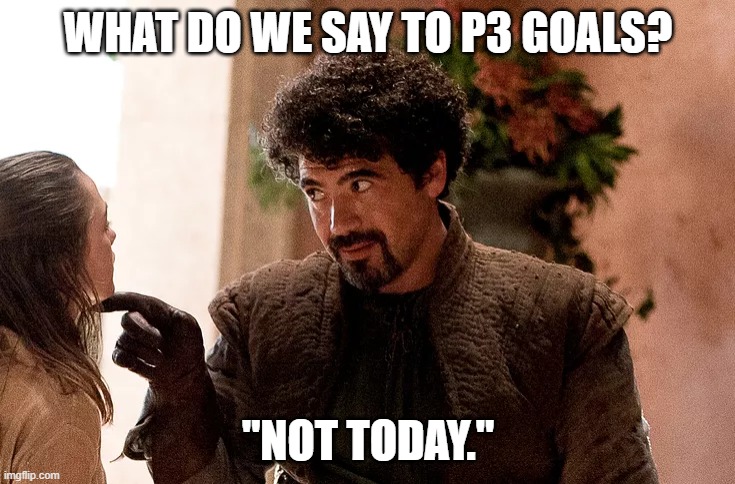Radical Prioritization
Summary
- Having too many priorities is the same as having no priorities. Your team’s list of priorities needs to be focused enough that they can use it as a decision-making tool when “surprises” inevitably arise.
- Prioritize ruthlessly. The goals prioritized just under your top priorities are especially dangerous; you need to actively steer your team away from working on those secondary goals.
- Priority buckets can provide a structure to help your team focus, and a shared language for talking about priorities.
- Don’t conflate the operational work that keeps your business running with the goals that move it forward.
- Focus wins. A team with clear focus on a small list of goals can make better decisions on the fly, leading to greater impact and success.
Hot Take
If your team regularly has dozens of quarterly or annual priorities (e.g. “OKRs”), your planning process is probably a waste of everyone’s time.
Ask yourself: when someone on your team needs to make a decision about where to focus scarce time, attention, or funding, does that list of dozens of goals help you make that decision? I’d wager the answer is “no”. In this article I will argue that having a long list of priorities is functionally the same as having no list, and offer some ways to solve that problem.
Too Many Goals = No Guidance
There’s a lot I could (and will!) write about prioritization but let’s start with just the length of your list of goals and priorities. In organizations I’ve worked in, it wasn’t uncommon to inherit either zero goals (management: “the team already knows what they need to do”) or a dozen or more “top” priorities (management: “these all P0—you need to finish all of them”). In the first case, the team explicitly has no guidance on priorities. You might think the second case is better, but a common (and true) saying is that “if everything is a priority, nothing is”: too many goals/priorities doesn’t provide any guidance, either. In both situations, when push comes to shove and team members need to make decisions, they’re on their own.
Warren Buffett is one of the most successful investors of all time. There are (possibly apocryphal, but that doesn’t matter for my example) reports that he considers the goals you intentionally say “no” to be just as important as what you say “yes” to. His “5/25” prioritization system is simple, but brutal:
- Write a list of your top 25 goals, in order of priority
- Draw a line between #5 and #6
- Everything above the line is what you focus on; everything below the line is your “avoid at all costs” list. They don’t just have “lower” priority—you and your team need to completely avoid working on them!
“Avoid at all costs”? But they’re priorities!
Top Priorities are Like Trampolines
Common law has a concept called the “Attractive Nuisance Doctrine” that may help explain Buffett’s draconian third step. Let’s say you have a trampoline in your backyard for your children (and yourself!) to play on. You’re concerned that neighborhood children might come over to play when there are no adults around, so you post “no trespassing” signs around it. Unfortunately, while you’re not at home, kids gleefully ignore your sign and start joyfully jumping away… until someone breaks their arm. Sad, but it wasn't your fault, right? Well, the Attractive Nuisance Doctrine says… yes, you very much are responsible: for over 180 years (it was climbing on a cart that attracted kids in those days) courts have consistently ruled that everyone knows trampolines attract kids like magnets, and putting up signs (and even building fences around them, if children might climb over) is insufficient: to avoid liability, the trampoline owner needs to take much more serious action to block children from playing on it.
Here’s how this applies to Buffett's 5/25 rule: priorities 6–25 are “attractive nuisances”: despite being told they are “lower” priorities, your team will constantly be drawn to working on them—yes, they’re lower priorities, but they’re still on the list! Just telling your team they’re lower priorities is like expecting a “no trespassing” sign to keep children away from a trampoline: that’s not enough! To keep your conscientious team members away from those lower priorities you need to send a stronger signal: don’t tell people they’re lower priorities—that they’re not priorities at all, and that they're dangerous, and that they should “actively avoid” them, instead. They need to be marked as deadly the way the nuclear waste burial site is marked in the cover image at the top of this post!
Priority Buckets: A Practical Framework
I’ll write another time about how to create a list of goals, build buy-in around their priorities, and distribute them across a network of sub-teams and individuals. For this article, let’s assume we’re starting with a long list of things we want to accomplish. We want to produce a priority list our team can use as a reference not just at the beginning of a quarter or year, but throughout their work as they run into surprises. To do that we need a system that sends clear priority signals for all the work on our list, using a common set of terms the whole team understands.
I like to approach this problem by splitting the whole list of work items into 5 priority buckets labeled, P0, P1, P2, P3, and P4. Here’s what goes in each bucket:
- P0s and P1s are a few items you want people to focus on. You can split work between P0 and P1 any way you wish, but the total number of P0 and P1 items needs to be small: 1–2 would be great, but no more than 3–5. The difference between P0 and P1 in this system is:
- P0 priorities are “must finish” items, what we called “OKR100s” at Google. They must be finished because other important work depends on them: for example, their delivery has been promised to customers or other teams, so failure to deliver them could have serious and cascading consequences. If a team fails to deliver on a P0, they need to do a formal postmortem review to develop and communicate why that goal wasn’t met, and what the team can do to ensure similar goals are successful in the future.

- P1 priorities are top priorities just like P0s, but they are more “stretch goals”: you’d like to finish them completely, but it’s understood that partial delivery is acceptable. At Google we called these “OKR70s” because a “70%” grade was considered successful for these items.
- P2 priorities are “targets of opportunity”. You keep P2s on your radar in case the stars align, but there's no expectation they'll get done: if they do, it’s a happy bonus. If the team is loaded appropriately, things go well with your P0s and P1s, and the team catches a lucky break or two, they might have the capacity to tackle one or two P2s… but it’s with the understanding that even partial delivery of a P2 is a bad thing if they have P0s and P1s that don’t get across the finish line. Like the P0 and P1 lists, the P2 list needs to be short: the idea is for the team to have consensus guidance on how to use potential “extra time”, and if the P2 list has more than a couple items on it we’re not really giving the team any guidance about how to use that time (rest assured: everyone on the team will have their own pet projects they'll dive into if that happens).
- P3 priorities is the team backlog, and it’s made up of the dangerous goals, the “attractive nuisances”. They’re important… but while they can be “sexy” to work on, any time spent working on them steals time and effort away from your P0, P1 (and maybe P2) goals. If anyone on the team is working on P3s, they’re rowing in the wrong direction and hurting the team’s chances of success. Accordingly, you need to do whatever you can to make it clear to people that P3s are in a no-go zone: surround them with (metaphorical) spikes and lakes of molten lava (here are some more ideas 😜). This doesn’t mean you’ll never do P3 items; every time you start a new execution cycle there’s an opportunity for last cycle’s P3s to become the next cycle’s P0s, P1s, or P2s. Just not today!

- P4 priorities come last; these are fantasy goals—unlike P3s, they will almost certainly never get done, for one reason or another. Why keep a list of goals no one will ever work on? Mostly, it's to maintain a “team memory” that these items were suggested, considered, and decided against, so the next time someone proposes doing in the future, people don’t have to go down the same rabbit holes again.
We’ll talk another time about how to run an effective intake and planning process, but for now just understand that you should put new work into your backlog (P3) and that all unfinished work P0–P4 gets reprioritized, potentially into a different bucket, at the beginning of every planning/execution cycle.
Operational Work: The Unspoken Top Priority
Your priority list won’t—and shouldn’t—cover everything your team is doing. In particular, your priority list usually shouldn’t include “operational” work, the work the team does to keep your business running. Operational work can be even more important than your P0s; some teams will spend more time on operations than on future-looking goals, while in other teams that will be reversed. Think of it like this: operational work keeps the lights on, and your P0 and P1 goals are what you’re doing to move your organization forward, using the energy you have left over. While they're not on the priority list, it's vital to the team's health that you account for the time they take when you size the number of priority goals they can take on.
How You Can Bring Order From Chaos, Today
If your team understands what they need to focus on, they’ll be equipped to make strategically-aligned decisions about where to concentrate their efforts as surprises come up. The way to do that is to keep a laser-like focus on just a few “top priority” goals, and to actively keep them away from “attractive nuisances”.
Here are some things you can do today to apply these ideas:
- Review and consolidate your current priorities. If a project is already showing signs of being off-track, you don’t need to wait until the next planning cycle: start building a consensus across the team now, about what to focus on in this cycle.
- Introduce a priority bucket system. Not all “priorities” are the same, so start delineating them into categories. You don’t need to use mine—use categories that will work for your team. The important thing is to make it clear where each goal stands in terms of priority using a well-understood set of categories.
- Focus, focus, focus. Resist temptations to add to your P0/P1 list. Sometimes adding another top priority, even “out of cycle”, is the right thing to do, but if you do, fight to drop something else from the list: it’s just the nature of reality that bright, shiny new goals will pop up all the time, but it’s physics that additional team capacity can’t come out of nowhere.
- Formalize planning. If your team doesn’t have a formal planning process, start working to sell the idea of establishing one. The best goals are the result of an informed, collaborative process, and that requires structure and time.
Do You Want to Know More?
If you’d like to go deeper into this topic, I recommend The Four Disciplines of Execution [affiliate]. This book goes into depth on not just the importance of having a very small number of priorities (that’s their First Discipline), but also the difference between leading and lagging metrics and the need to focus on leading metrics to drive execution (the Second Discipline), building and communicating a metric scoreboard to track progress (the Third Discipline), and building a cadence for review, discussion and accountability (the Fourth Discipline).
Typical of the topics I plan to write about in this newsletter, these are the sorts of things people sort of figure out on their own along their way but implement inconsistently because they’re not thought of as a complete system. Four Disciplines of Execution does a nice job of laying out a complete approach to prioritizing, focusing, and reinforcing goals, with lots of examples and case studies.
What Do You Think?
I'd love to hear about your experiences with priority lists, long and short! If you're a paid supporter of this newsletter (hint, hint!) you can add comments below.

